This Dr. Axe content is medically reviewed or fact checked to ensure factually accurate information.
With strict editorial sourcing guidelines, we only link to academic research institutions, reputable media sites and, when research is available, medically peer-reviewed studies. Note that the numbers in parentheses (1, 2, etc.) are clickable links to these studies.
The information in our articles is NOT intended to replace a one-on-one relationship with a qualified health care professional and is not intended as medical advice.
This article is based on scientific evidence, written by experts and fact checked by our trained editorial staff. Note that the numbers in parentheses (1, 2, etc.) are clickable links to medically peer-reviewed studies.
Our team includes licensed nutritionists and dietitians, certified health education specialists, as well as certified strength and conditioning specialists, personal trainers and corrective exercise specialists. Our team aims to be not only thorough with its research, but also objective and unbiased.
The information in our articles is NOT intended to replace a one-on-one relationship with a qualified health care professional and is not intended as medical advice.
20-Minute Kettlebell Workout, with 5 Best Kettlebell Exercises
May 8, 2023
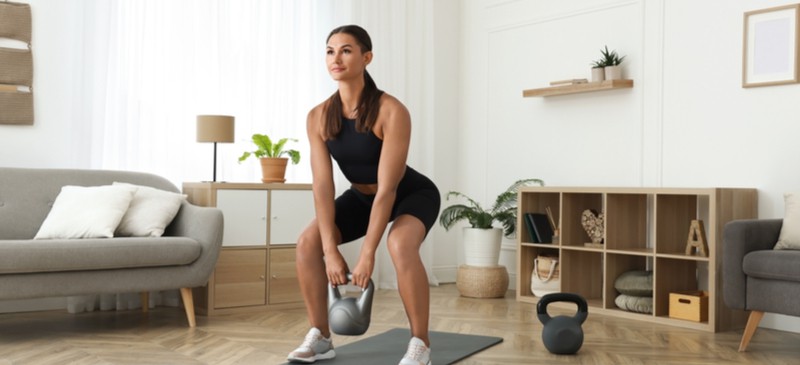
Ready to get in great shape, without sparing any more time than it would take you to watch one episode of your favorite show? Well, this full-body, heart pounding 20-minute kettlebell workout is for you.
Kettlebells promise quick results that boost endurance, burn mega calories, build tons of strength and even increase flexibility. So what does that mean for you?
No longer will you need to run on the treadmill and then lift weights afterwards. Aside from simultaneously targeting almost every part of your body, when used properly, the beauty of kettlebell workouts is that they can be done quickly and require very little equipment (only one kettlebell). You can even complete this whole 20-minute kettlebell workout in your own living room if you wanted to!
The key to getting the most of your 20 minutes. Strategically going from one exercise move quickly into the next. The result is that you get a fast, full-body, cardio and strength-building workout at the same time, wherever you choose — win, win!
What Is a Kettlebell Workout?
Although they’ve been getting tons of praise in recent years and are still growing in popularity, kettlebell workouts are nothing new to the fitness world; they have been popular around the world for centuries, especially in places like Russia. It’s believed that they got their start in Ancient Greece and later spread to Russia around the 18th century, where kettlebells are still extremely popular and meaningful today.
In Russia, kettlebells were first used as a means of measuring crops and goods for trade, but people quickly caught onto how much strength could be built by maneuvering kettlebells around all day. At this time Russians began competing with kettlebells and featuring kettlebell strength competitions at festivals and fairs for amusement.
Kettlebells came to North America in the 20th century after a Soviet Special Forces physical training instructor introduced the cast iron weights and their various physical benefits to a new interested population of exercisers.
It didn’t take long for fitness magazines, websites and enthusiasts to pick up on the kettlebell workout trend. In the early 2000’s, RKC certification was established that qualified “Certified Kettle Bell Instructors.” Since this time, other organizations and certifications have been put in place, and kettlebells have become widely popular and used in almost every gym across America.
Kettlebell workouts are able to effectively target your major muscle groups — shoulders, core, back muscles, quadriceps, hamstrings and more — all in a short duration of time.
Benefits
1. Kettlebell Workouts Prevent Over-Exertion
Many studies have shown that performing too much cardiovascular exercise, especially long-distance aerobic exercise like marathon running, can actually do a lot of damage to your body.
Some experts even feel that over time the negative impact of putting a lot of stress on the cardiovascular system (as it works hard to pump out extra blood during long-distance cardio sessions) can sadly even contribute to a shortened lifespan.
High-intensity internal training (HIIT) or strength building exercises do not have the same effect on your heart as standard aerobic activity sessions do, and health authorities now agree that shorter, more intense bursts of exercise should play a significant part in the average person’s exercise regimen.
For example, recently the World Health Organization (WHO) began advising that “Adults aged 18–64 should do at least 150 minutes of moderate-intensity aerobic physical activity throughout the week or do at least 75 minutes of vigorous-intensity aerobic physical activity throughout the week, or an equivalent combination of moderate and vigorous-intensity activity.”
Fast-moving kettlebell workouts, in which you perform one move directly followed by the next move with little time to rest in between, is an excellent way to get your heart rate up for a shorter, more intense period of time.
This allows you to complete a healthy 20-minute workouts that benefits your body by building all-over muscle and simultaneously reducing fat, but it doesn’t put an unnecessary amount of prolonged stress on your heart, joints, or other susceptible organs.
2. Kettlebells Fight Age-Related Weight Gain
Research has shown that adults experience an average of 3 percent to 8 percent loss of muscle mass every decade, which means that resting metabolic rate is reduced — or the number of calories someone is able to burn on an average day.
This means more dangerous fat winds up accumulating around susceptible organs like the heart and liver, which are especially important to keep healthy in order to prevent disease.
The same study showed that just 10 weeks of consistent resistance training can help a slow metabolism and actually increase resting metabolic rate by 7 percent; this number may not sound like a lot, but who doesn’t want to continuously burn 7 percent more calories each and every day?
While kettlebell workouts — along with other forms of exercise like HIIT and Tabata workouts — lead to an increase in metabolism, they also tend to effect increases in appetite less so than prolonged cardio sessions do. This means you are less likely to overeat if you focus on including a number of different exercise programs into your routine, including yoga, as opposed to only performing cardio.
3. Kettlebells Protect Against Numerous Age-Related Diseases
Aside from warding off unhealthy weight gain, studies show that strength training can also improve general physical performance, movement control, walking speed, abilities to concentrate and make decisions, and even general self-esteem. Strength training also plays a part in preventing the onset of type 2 diabetes, which is closely associated with unhealthy weight gain and inability to control blood sugar levels.
By reducing weight and improving insulin sensitivity, adults are able to reduce the risk for metabolic syndrome, diabetes and other inflammation-caused diseases that are related to the resistance of insulin. Resistance training may also be effective in defending against cardiovascular disease by reducing resting blood pressure and bringing cholesterol and triglyceride levels back to a healthy state.
Finally, studies have shown that strength training is extremely important for maintaining the structure of the skeleton and that resistance training may promote bone development and delay the loss of age-related bone mineral density. This is often the reason why older people, especially women, are highly encouraged to lift weights at least two times per week — because it can help ward off osteoporosis, a serious concern for post-menopausal women in particular.
4. Kettlebells Improve Posture and Agility
There is a real emphasis today in the fitness world to practice exercises that have a practical purpose in our lives. “Functional exercises,” like kettlebell workouts, help to keep our posture upright, our endurance at its peak and our muscles prepared for whatever may come.
Because your body is moving in multiple directions and on different angles at every moment during a kettlebell workout, you experience dynamic, full-body results that are actually useful in real-life situations. This is the same reason maybe people are drawn to CrossFit workouts.
While standard weight machines may help in building muscle, they tend to target only certain specific muscle groups at one time and not entire regions of the body (like the entire core or both of the whole arms, for example). Kettlebells have the ability to build strength in multiple muscle regions of the body all at once, offering full-body integration and core stabilization, and again saving you time!
5. Kettlebells Are Versatile and Easy to Adapt
Whether you are a very experienced weight lifter who’s in fantastic shape, or are a middle-aged woman who is relatively new to hitting the weight room at the gym, there is a way that kettlebells can benefit you. Kettlebells’ versatility depends on you choosing a weight that’s best for your body and current abilities, then practicing moves that target the areas of your body you’re most looking to improve.
Want to build more shoulder strength? There are plenty of moves that got you covered. Interested more in getting your heart rate up and burning lots of calories? There’s a series of moves that will work for that too.
6. There is No Need for Large, Pricey Equipment
Kettlebells are portable and pretty inexpensive to buy, especially when you consider how much money most large pieces of gym equipment, or fitness class packages, can cost you. Most kettlebells can be bought for around $30-$60 depending on the weight, and found at any large sporting or fitness store, as well as online. They’re also often available at used sporting goods stores.
If you join a gym, you will likely have access to many different kettlebell weights as well. However, one of the biggest perks of owning a kettlebell is that it virtually turns your home into a gym. Performing a 20-minute kettlebell workout takes little space, so you can practice in the comfort of your own yard, basement or apartment whenever time allows you.
7. Kettlebells Have a Unique, Effective Shape
The fact that kettlebells have a true handle for picking them up and holding on while you move them around means that you can keep your workout moving along. There is no need to halt your circuit routine in order to stop, drop and adjust the weight, which is typically the process when using normal free weights or dumbbells.
While dumbbells, large weight machines and bench-pressing weights all require time to readjust alignment and your grip, kettlebells can quickly be shifted around in your hands without you needing to pause — making your workout more aerobically effective since you are able to keep your heart rate up, and shorter in duration, too.
Kettlebell Workout Preparation
If you are brand new to kettlebells, it may be a wise idea to speak with a personal trainer or friend who uses them frequently and can make sure your alignment is correct before you get going. This way you don’t risk injuring yourself or missing out on all the benefits that kettlebell workouts can offer.
However, if you’re no stranger to the gym and using other weights and strength-building equipment, then you will likely be okay jumping right into the world of beneficial kettlebell workouts.
1. Choosing Your Weights
Your first step is to pick which weight you will use. Different kettlebell workout moves are best done using different weights. For example, “ballistic” moves that involve “explosive” bursts and quicker movements usually are most effective when done with heavier weights.
Heavy weights work well with ballistic moves like swings, snatches and “cleans” because you get momentum going completing these movements. On the other hand, slower “grind” moves (windmills, overhead presses, etc.) usually require lighter weights since they need to be carefully controlled and do not just rely on momentum.
For both men and women, it’s always a good idea to start out on the lighter, safe side and work your way up to using heavier weights during your kettlebell workout. There is a big range in recommended kettlebell weights depending on your current fitness level and strength. Try using a lighter weight first and working your way up to one that is more challenging.
- Women: The best choices are kettlebell weights that are between 4 kg/9 lbs. all the way up to and 16 kg/28 lbs.
- Men: Try using a kettlebell between 12 kg./26 lbs. and 28 kg./62 lbs. and following the same guidelines, working your way up as you gain strength and familiarity with the moves.
2. Building Your Workout
Keep in mind that you can always easily create your own circuit kettlebell workouts, different then the one described below, by combining your favorite kettlebell moves.
In order to do this, it helps to first get familiar with the basic strength-training terminology if you aren’t already: sets, reps and rests/intervals. You will see these terms used below in the 20-minute kettlebell workout that’s described, and you can use the same principles to create multiple short, intense workouts:
- Rep: A rep is every time you lift and lower a weight. You complete reps back to back, and this makes up a set.
- Set: Sets are groups of reps. You complete all the reps in one set without taking a break. Then you take breaks between sets.
- Rest or interval period: This is the pause between sets where you rest and catch your breath for a short period of time (usually 30 seconds to a 2 minutes, depending on the person and how vigorous the workout is).
Here is an example of how to put these terms into play during your kettlebell workouts: “You will complete 10 reps of a kettlebell move, which equals one set. Then you will rest, and complete another set of 10 reps.”
It is important to remember that your set and rep number always depends on how fit you currently are and your level of endurance. Most kettlebell workouts (and weightlifting programs in general) recommend aiming for 2 to 3 sets total. For the 20-minute workout below, you will complete 2 sets.
Within each set, it’s best to stick with doing 10–20 reps. You will be able to determine the amount of reps you can successfully do by paying attention your form; once you are sacrificing good form due to becoming exhausted, its fine to put the weight down and take a break, or else to move on to another move that targets other muscle groups. Otherwise, doing more reps will not produce better results, and may even cause an injury.
20-Minute Kettlebell Workout Routine
You will go through the following 5 kettlebell exercises in a circuit:
- Perform each move for about 1 minute
- Resting shortly for only about 30 seconds
- Move on to the next move
- After you complete all 5 moves once, rest for 1-2 minutes and repeat the whole circuit for the second time
1: Basic Kettlebell Swing
- Trains these muscles: quadriceps, hamstrings, core
- Reps: About 20 (or as many as you can repeat in 1 minute)
- Sets: 2
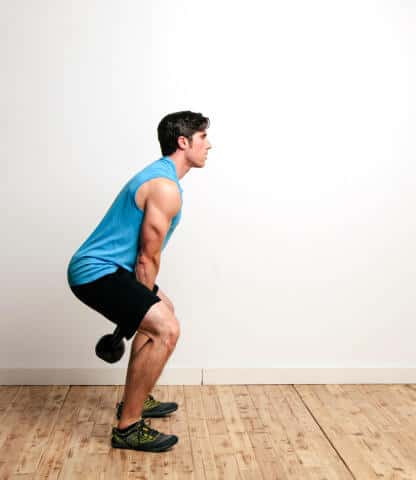
Exercise form:
- Begin with your feet hip-distance apart. Pick up your kettlebell using both hands firmly on the handle.
- Come into a squat position by bending your knees and hinging from your hips. Act like you are sitting back in a chair, using your quadriceps and hamstrings to keep you stable. Work to swing the kettlebell down and back between your legs.
- Come up as you straighten your legs and swing the kettlebell in front of you and up to about the level of your chin. Get momentum going, but work from your legs and core, rather than just your arms.
- Repeat as many times as you can within 60 seconds, aiming for about 20 swings. Rest for 30 seconds, then move on to the next move.
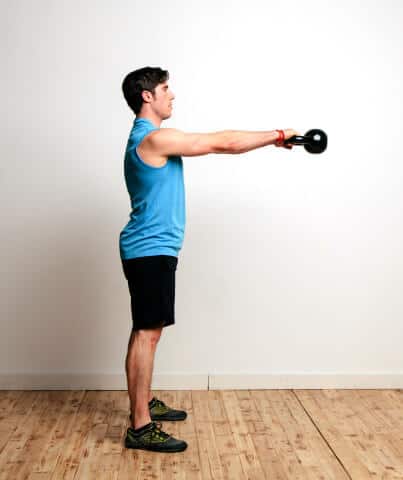
2. Lunge and Press
- Muscles trained: core, quadriceps, glutes, shoulders
- Reps: About 20 (or as many as you can repeat in 1 minute on each side)
- Sets: 2

Exercise form:
- Begin with the weight in your hands held at the top of your shoulder height.
- Step your left leg forward into a lunge.
- Press the kettlebell above your head and then lower it back down.
- Stand back up and bring the kettlebell back to shoulder height.
3. Sit and Hold
- Muscles trained: entire core, legs, shoulders, biceps, upper and low back
- Reps: Lift butt and feet off the ground, hold and then lower. Repeat for 1 minute.
- Sets: 2
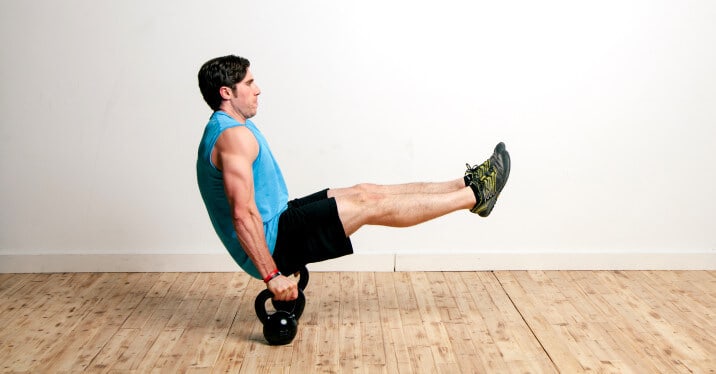
Exercise form:
- Place both hands on standing kettlebell handles. Make sure both kettlebells are directly below your shoulders.
- Make sure to keep your core actively engaged lift your butt and feet off the floor keeping your arms and legs straight.
- Bring your body forward so that your butt is positioned directly between your wrists.
- Hold this position for as long as possible and repeat.
4. Weighted Squat and Lift
- Muscles trained: shoulders, biceps, core, legs
- Reps: About 20 (or as many as you can repeat in 1 minute)
- Sets: 2

Exercise form:
- Start by standing upright with feet hip-width apart. Have the kettlebell held into both hands at chest height, close to your body.
- Lower down into a low squat; the goal is to get low enough for the thighs to be parallel to the floor. Try to keep the back straight rather than arched, using the core to hold you in place.
- Return to back to starting position, coming up out of the squat and simultaneously lifting the kettlebell directly over your head using both hands. Repeat as many times as you can for 1 minute.
5. Windmill
- Muscles trained: obliques, shoulders, biceps, lower back
- Reps: About 20 (or as many as you can repeat in 1 minute straight)
- Sets: 2
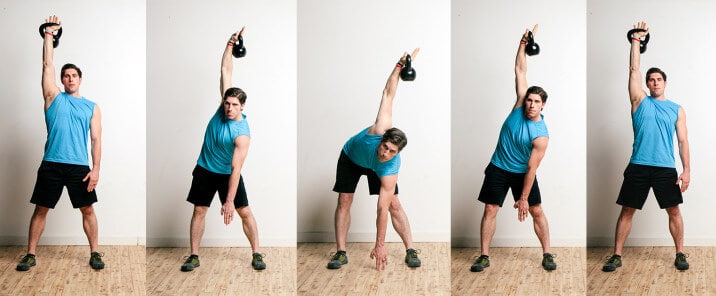
Exercise form:
- Start by standing upright with feet a bit wider than hips-width apart. Hold the kettlebell in your right hand first.
- Facing forward between your legs, bend to the left side over your leg, keeping both legs straight and reaching with your left hand to the floor. Your right hand holding the kettlebell should come up and over your right shoulder. Look up at the ceiling towards the kettlebell.
- Come back upright, repeating on the same side by using your arm strength to lower and raise the kettlebell in your right hand. Repeat on the same side for 30 seconds, then switch sides.





